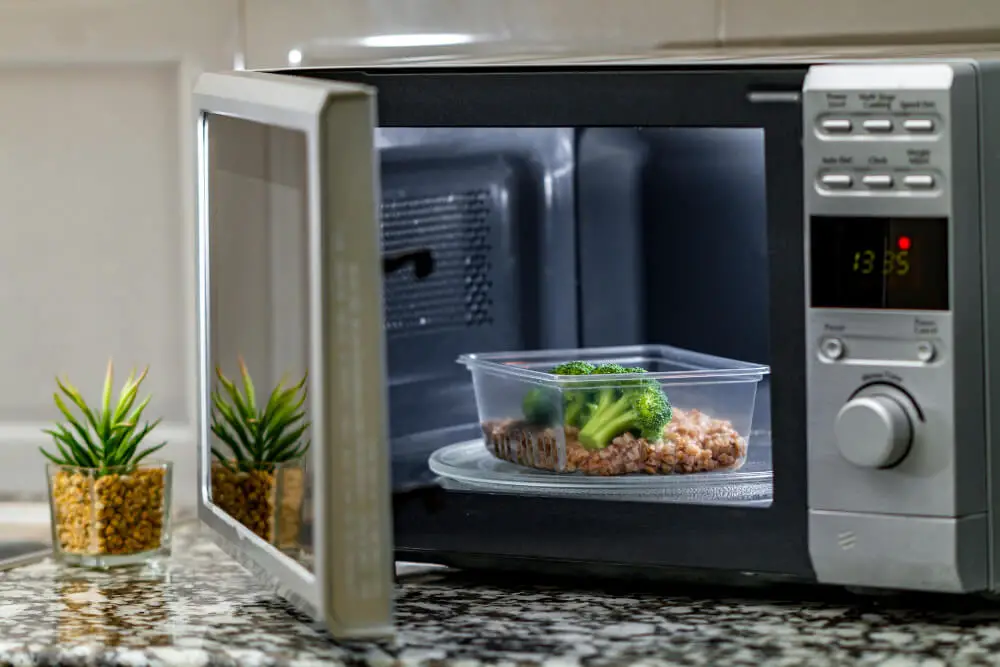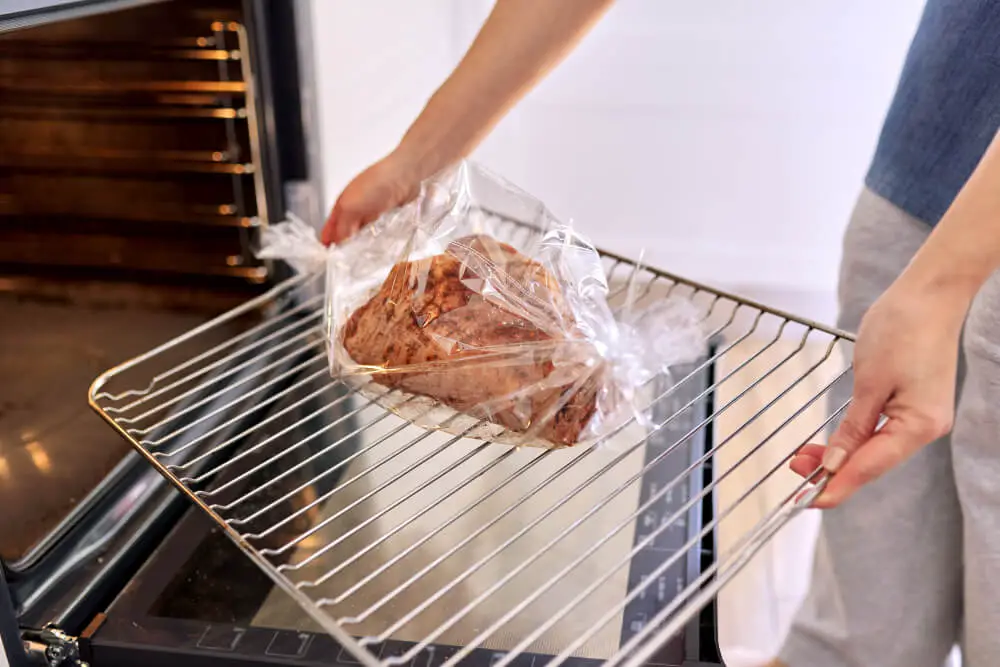Last Updated on August 6, 2023 By Emma W. Thomas
If plastic has melted in the oven, it’s unsafe to eat food cooked in it. The melted plastic can release harmful fumes and contaminants. Clean the oven thoroughly before using it for cooking again.
8 Reasons why you should not eat food when Melted Plastic in the Oven found

- Food safety. If you leave a piece of melted plastic in the oven for a long period of time, a toxic chemical is released into the air and can be inhaled or ingested by anyone who opens the oven door. You may also ingest food with harmful chemicals from contact with the melted plastic.
- Household safety. If you let a piece of melted plastic stay in your oven, it might cause fire or electrical shocks, especially if there are any electrical appliances close by that could come into contact with the contaminated surface.
- Cleaning and health risks: If you have leftover food with random pieces of plastic mixed in it, this might be a sign that there was potential.
- Melted plastic in the oven can be harmful and may cause irritation to your skin and eyes. It may contain chemicals that are toxic. It is also difficult for the eye to absorb, making it more likely that people will eat this type of plastic material without knowing.
- There is a risk of choking.
- The smell might make you sick.
- There are many different types of harmful chemicals in these plastics, some of which are known to cause cancer. These plastics can leech into your food and you can ingest them without knowing it.
- The melted plastic can drip into your food and cause health problems that are difficult to detect.
Does Plastic Release Toxins When Melted?
1. Release of Harmful Dioxins
When plastics are heated or melted, a group of highly toxic chemical substances known as dioxins are released. Dioxins not only pose a serious threat to the environment but also to human health due to their tendency to accumulate in the food chain.
2. Production of Polychlorinated Biphenyls (PCBs)
Another set of toxin compounds emitted by melting plastics are polychlorinated biphenyls (PCBs). Similarly to dioxins, these compounds are incredibly toxic and can have detrimental effects on human health.
3. Emission of Heavy Metals
Certain types of plastic contain heavy metals, such as cadmium and lead, which can be released upon melting. Exposure to these heavy metals can lead to various health issues, including reproductive, developmental, and neurological disorders.
| Plastic Types | Toxins Produced When Melted |
|---|---|
| Polyvinyl Chloride (PVC) | Dioxins, PCBs |
| Polystyrene | Styrene |
| Polyethylene Terephthalate (PET) | Antimony trioxide |
| High-Density Polyethylene (HDPE) | Toxic gases like carbon monoxide |
4. Risk of Cancer
Given that both dioxins and PCBs are known carcinogens, people who are frequently exposed to these toxins have an increased risk of developing several types of cancer.
5. Exposure to Endocrine Disruptors
Melting plastic can also emit compounds such as phthalates and BPA, which are known as endocrine disruptors. These compounds interfere with the normal functioning of the endocrine system and can lead to an array of health issues including hormonal imbalances, reproductive disorders and developmental problems in children.
6. Respiratory Issues
The fumes produced during the process of melting plastic can cause acute respiratory problems. Exposure to these fumes can launch an immediate and intense inflammatory response in the lungs, causing symptoms such as coughing, wheezing, and shortness of breath.
Given these points, it’s clear that melting plastic poses considerable dangers to human health and the environment. Adopting safer waste management practices and reducing the use of plastics can significantly lower the risks associated with these potent toxins.
What Should You Do If You Accidentally Burn A Plastic Into An Oven?
The most important thing that you need to do is to clean your oven. When it comes to cleaning, there are various ways of it, depending on the type of oven. There are various types of ovens and their cleaning procedure is different, which we will discuss later. For now, you should know that cleaning is imperative.

How To Clean Different Kinds Of Ovens?
We have already discussed that cleaning different types of ovens follows different procedures when it comes to cleaning. So, let us have a look at them. It will help you to clean your oven in the future if plastic melts in it.
1. Regular Electric Oven
If plastic melts in your regular oven, all you have to do is to place a bag of ice directly into the melted plastic. After that, you have to give it some time to chill. It will make the plastic more brittle. Next, you have to lift the plastic puddle, using a razor blade scraper. While doing this, you have to be quite careful. Or else, there is a possibility that it will create some unwanted incidents. Well, there is no need to worry, as this process will not hamper the finish of interior porcelain.
2. Oven With A Self-Cleaning Feature
To activate this feature, the first thing that you have to do is to turn on the oven. After that, you have to set it to its lowest setting. Once you do that, you have to wait a bit. When you find out that the plastic became a bit pliable, you have to get a spoon or a spatula. With the help of them, you have to remove the melted plastic from the surface. Instead of a spoon or a spatula, if you use any other materials, there is a possibility that they will damage the floor of the oven.
3. Regular Gas Oven
Here, you need to turn off the gas first. The next thing that you have to do is to take the bottom panel out. For that, you have to look for the screws at the back. There will be two screws, which you can remove. Removing those screws will allow you to lift the base plate. After that, you can put the panel into the freezer, if it fits. You have to keep that in your freezer until the plastic becomes brittle so that you can scrap it out. If you find out that this process is a bit complicated, you can use the bag-of-ice technique. To do that, you have to keep the panel flat on your kitchen counter.
How To Get Rid Of The Burnt Plastic Smell?
If plastic burns in your oven, it will create a bad smell. It will ruin the environment of your home. Besides, it comes with numerous adverse effects. It will not only affect your lungs, but it will also affect your brain. Hence, the best option for you is to get rid of the smell. To accomplish that, you have to follow some steps. So, here are the steps that we are talking about.
| Steps | Description |
| Step 1- Identify The Smell | It is the fundamental thing that you need to do. Identifying the smell of tic is the most important thing. Or else, it may create some unwanted issues in your lungs and other parts of the body. The main purpose of identifying the smell is to get noticed when the plastic is burning in the oven. Well, you have to identify it as soon as possible. |
| Step 1- Ventilate The Smell | Once you remove the plastic from the oven, you have to make sure that you are ventilating the room. The smell of the plastic is unpleasant as well as dangerous. Hence, your priority should be to make the air breathable and safe again. Don’t forget to open all the windows to ensure the proper circulation of air. It will help the harmful materials to dissipate through the air. |
| Step 3- Clear The Smell | Before clearing the smell, you have to keep your windows open for at least one hour. Once you clear out the substantial smoke from your house you have to now think about clearing the air. You will get various air fresheners and candles. However, they will only mask the smell instead of making it go away. Therefore, always try to opt for a deodorizer that is natural and safe. Well, in that case, we would suggest you use white vinegar. It will absorb the bad odor and the smell will go away. |
What Will Happen If You Leave Some Plastic In The Oven?
If you keep some plastic in an oven, it may melt down, or nothing may happen. It depends on the plastic that you are using. Well, some plastics are compatible with the oven. In case, if the plastic is not oven-friendly, it may release carcinogenic gas when combined with cooking gas. In that case, you have to clean the oven as soon as possible.
Final Verdict
You can eat the food even after the plastic melts in the oven. However, the best option for you is to avoid that. It will be a healthier alternative if you can clean the oven after the plastic melts in it. We have discussed the ways of removing melted plastics from different types of ovens. You can follow those techniques and get rid of them. After that, you can cook without any issues or worries.
References:
https://kitchenbun.com/melted-plastic-in-oven-still-eat-food/
https://oventutor.com/melted-plastic-in-the-oven-can-i-still-eat-food/
Emma is a graduate of Domestic Science or Family and Consumer Sciences (Home Economics) from the University of Wisconsin. She has 7 years of experience Working with the strategic section of BestBuy and now writing full-time for Homeeon.
From Managing the Home, Interiors, Cleaning, and Exteriors to Gardening and everything about Making A Home Liveable – is her passion and this Homeeon is the result of this.
Emma loves decorating her home with the best stuff found online. She cares about quality over anything and writes reviews about them here in Homeeon. Get in touch with her over Pinterest.
Keep reading her blogs.
